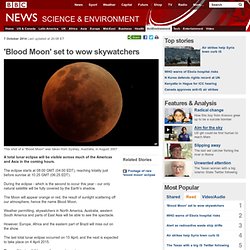

'Blood Moon' lunar eclipse seen in Americas and E Asia. 7 October 2014Last updated at 20:08 ET This shot of a "Blood Moon" was taken from Sydney, Australia, in August 2007 A total lunar eclipse will be visible across much of the Americas and Asia in the coming hours.

The eclipse starts at 08:00 GMT (04:00 EDT), reaching totality just before sunrise at 10:25 GMT (06:25 EDT). During the eclipse - which is the second to occur this year - our only natural satellite will be fully covered by the Earth's shadow. The Moon will appear orange or red, the result of sunlight scattering off our atmosphere, hence the name Blood Moon. Weather permitting, skywatchers in North America, Australia, western South America and parts of East Asia will be able to see the spectacle. However, Europe, Africa and the eastern part of Brazil will miss out on the show. The last total lunar eclipse occurred on 15 April, and the next is expected to take place on 4 April 2015. There will be two full lunar eclipses again next year. Will you be watching the eclipse?
New astrological sign: Professor finds horoscopes may be a little off kilter - Page 2. The astrological calendar is all wrong.

That public comment from a Minnesota astronomy professor set the Internet aflame this week. People might think they're a Pisces (compassionate, imaginative), but often they're really an Aquarius (witty, clever) -- at least based on an exact reading of the Earth's orbit. Or maybe, if you were born between Nov. 29 and Dec. 17, you're actually a strange new zodiac sign: Ophiuchus, the serpent holder. But who wants to admit to being that snake-guy sign on a first date? More from Science: What's in a thunderstorm? "I defined the zodiac by the constellations that are in the background when you look at where the sun, moon, and stars are," said Minneapolis Community and Technical College instructor Parke Kunkle, the man responsible for momentarily turning the astrology world upside down.
In Kunkle's 13-member zodiac, the signs occupy more or less space on the calendar depending upon how long they are in the sun's path. --Capricorn: Jan. 20-Feb. 16; TheAbysmal Calendar - Calendar Wiki. The Abysmal Calendar has been developed as a replacement for the Gregorian calendar in its role as the global standard.

It was developed anonymously from December 21st 2005 to December 20th 2007 in Vancouver Canada. The Abysmal Calendar seeks to harmonise a number of different Calendars’ features in order to provide the most eloquent means of translating dates between one Calendar system and another, and for communicating dates across the world's cultures. Abysmal Calendar’s Components Edit The Abysmal Calendar has several components, each of which assigns numbers, numerals or names to each particular Day, such that it may be more easily grouped into weeks, months, years and other measures of Days. A Chromatic Counter Lunations (aka Lunar Months) the 52-Week Perpetual Year and other features.
In almost every case, the Abysmal Calendar begins the numbering of time periods with 0, followed by 1, 2, 3, etc... Chromatic Counter Edit The initial periods occur as follows: Lunar Calendar. TheAbysmal Calendar « theAbysmal. “The material of myth is the material of our life, the material of our body, and the material of our environment, and a living, vital mythology deals with these in terms that are appropriate to the nature of the knowledge of time.” — Joseph Campbell theAbysmal Calendar – Rethink, Reform, Revolute theAbysmal Calendar is designed to replace the Gregorian Calendar as the calendar shared by the world (but people are still free to continue using it, of course).

Advantages include: Why theAbysmal? Nothing’s better. Calendar Dates.